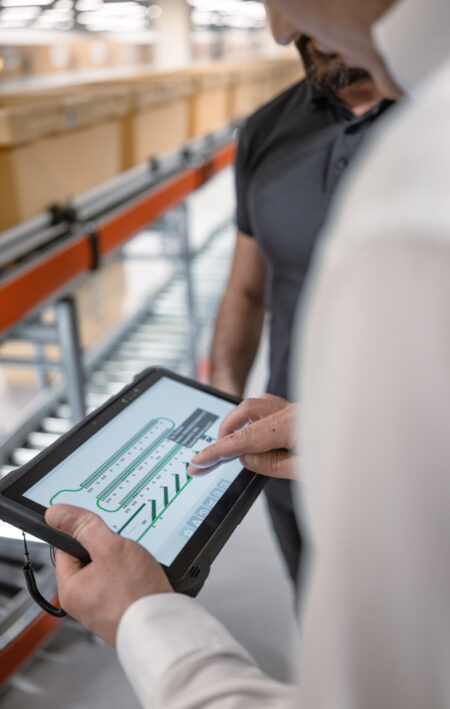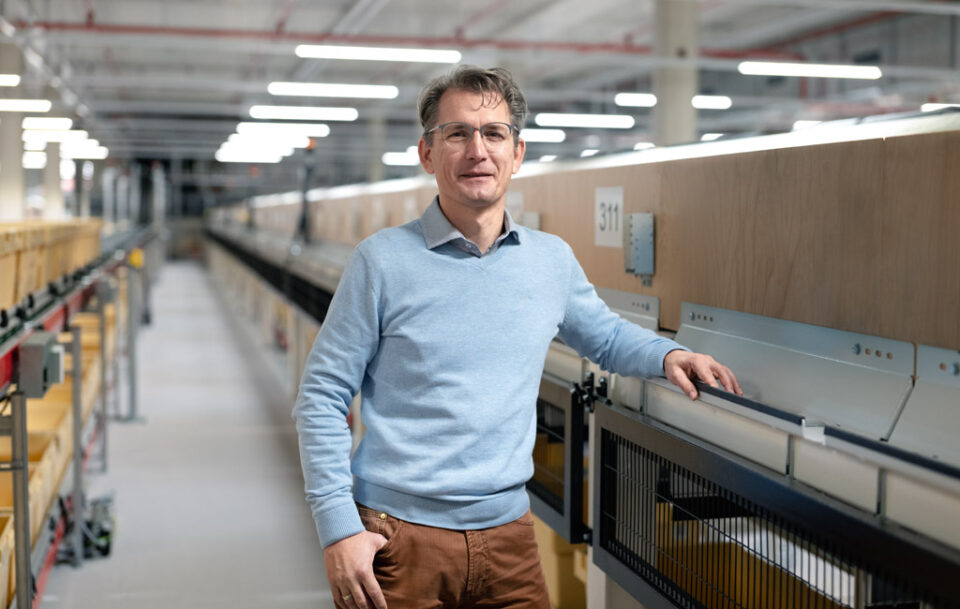At the logistics center in Weiden, everything is buzzing along without a hitch. Clothing and other items picked beforehand from mail-order company Witt Group arrive at the sorting system on the moving conveyor. There, the goods are scanned to identify them and are transported into the correct shipment tray at the system’s outlets. Equipped with flyers or give-aways, the collected items arrive at the next stage in the right-sized shipping carton and then go out to the customer. Order completed. To ensure that everything runs smoothly, sophisticated technology is required, which also has to fulfill ever greater sustainability requirements.

André Sielemann, Controls Manager Logistic Systems at the BEUMER Group, values the long-standing partnership with ebm-papst. (Photo | Stefan Hobmaier | Fotogloria)
Increasing the sorting capacity in a sustainable way
This is what the Witt Group contacted the intralogistics experts BEUMER Group to order. They wanted to expand their existing logistics site in Weiden to increase their available sorting capacity by at least 50 percent. Their most important request was having a solution that is as efficient and sustainable as possible. “Our high-performance sorter was ideally suited to this challenge for the broadest mix of items. The BG Sorter Double-Belt can accommodate the shipment using one or two load carriers,” explains André Sielemann, Controls Manager Logistic Systems at the BEUMER Group.
“It has efficient servo and variable frequency drives, non-contact energy transmission, real-time communication with the sorter, and intelligent automation technology for smart data.” To go the extra mile in terms of sustainability, BEUMER also used servo drives rather than pneumatic drives to open and close the flaps that convey the picked items from the sorting chambers into the shipment trays. Sielemann: “We decided to use the ECI drive from ebm-papst. In addition to the desired efficiency and sustainability, it also provides our systems with that extra amount of precision and intelligence.”
No sooner said than done. The 275-meter sorting system is now the heart of the logistics center in Weiden. It uses five feed units to pick up items and sorts them out again in over 290 sorting chambers per sorting wave. This constitutes over 10,000 items per hour, 20 hours a day, six days a week. The ECI drives are used as small helpers in each of the 290 flaps, which cause the buffer items from the sorting chamber to fall into the shipment tray for each order. They reliably control the flaps 2,000 to 4,000 times a day and send the orders to the right basket. But what makes the drives so sustainable and intelligent?
Replacing pneumatics with ECI
Switching from pneumatic to servo drives alone serves both efficiency and sustainability. It starts with the energy source. The servo drive has a much lower power requirement than compressed air generation. The difference is also noticeable when it comes to maintenance: if pneumatic solutions need to be readjusted after thousands of movements, servo drives are much less prone to maintenance and servicing, which gives them a longer product cycle.
This is automatically kind to the wallet: the amount of service costs are reduced and the total operating costs also decrease. “This saving is often crucial for systems that have long operating hours,” says Sielemann. “These little things have a big effect overall.” The ECI drive from ebm-papst tips the scales.

Productivity increased: with the new system, the Witt Group can dispatch 50 percent more packages than before. (Photo | Stefan Hobmaier | Fotogloria)
Smart ECI drive
“The modern technology of our ECI servo drives creates the perfect interplay of efficiency and sustainability,” says Markus Psik, Head of Sales for Industrial Drive Technology at ebm-papst. “They have integrated control electronics and sensors, have IoT capability and, thanks to GreenIntelligence, are also state-of-the-art in terms of predictive maintenance.” With the ECI 63 drive from ebm-papst, BEUMER went all out. “This gave us a solution that is efficient from every perspective,” says Sielemann from BEUMER.

Important instrument: BEUMER monitors the status of the system with tablets. Machine data from ECI drives and other areas are prepared and used for optimum operation and predictive maintenance. (Photo | Stefan Hobmaier | Fotogloria)
But what can the intelligence of the drive do that others cannot? Firstly, the ECI 63 integrates the sensors that were previously separate and had to be maintained with pneumatic drives. The servo drive automatically detects the position of the flap and initiates its next action as a result. Its CAN bus interface makes it easier to control the entire field bus network. “Thanks to its small size, the ECI 63 is very suitable for intralogistics solutions such as this,” explains Psik from ebm-papst. “Also, the EtaCrown angular gearbox is especially efficient, helping to save energy.”
Go green with GreenIntelligence
The fine add-on: thanks to the ECI 63’s GreenIntelligence, both BEUMER and the Witt Group themselves have easier access to more machine data. This data is then processed by the BG Insight software solution and can be viewed at any time via smart data dashboards. “This means important added value for our systems when it comes to predictive maintenance. This makes our systems ever more intelligent themselves,” says Sielemann. “In addition, it also helps technicians at the Witt Group to constantly improve technical availability.”
This is how the software errors are analyzed and warnings of potential faults are provided. A simple example: based on the machine data, the software detects that the flap always gets jammed when two specific articles are ordered together — a foot mat and a winter jacket. Thanks to its integrated sensors, the ECI drive detects the problem and stops so as not to damage the goods. The smart data dashboards report the error, giving the valuable information that these two items should be sorted separately in the future.

Michèle Hille from the Witt Group is impressed by the high technical availability during operation combined with a robust delivery promise. (Photo | Stefan Hobmaier | Fotogloria)
Flap open, flap closed!
Just half a year after the order was submitted, the Witt Group benefited from the new sorting system with the intelligent drive. After all, as a standard product, the drives were immediately available for delivery. “With the new packing and sorting system, we are combining completely new opportunities for compiling shipments,” says Michèle Hille from the Witt Group. “We are impressed by the high technical availability during operation combined with a robust delivery promise.”
Switching to servo drives has paid off. “The change is in keeping with the times and increases the sustainability a lot thanks to reduced energy consumption during operation,” says Hille. In recent decades, there have already been major steps in the development of individual components in many areas and this is expected to continue. “For us, collaborating with ebm-papst is not a one-hit-wonder,” says Sielemann. “We still want to further expand the sustainability and intelligence of our systems.”

Leave a comment